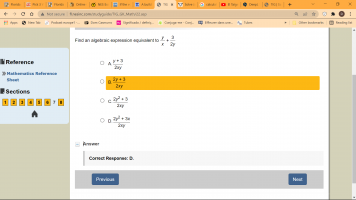Thank you, Jeff. I would love to get to know how to apply this principle to the problem. I have an idea but do not know to apply that.
Let’s straighten things out.
First, I presume you are talking about my post # 3 rather than my post # 5, which explains when and why cross multiplication is valid. That post is not about how to solve your problem.
Second, instead of memorizing specific procedures, rely on general principles if you want to develop your mathematical muscles.
Here is the specific problem. You are asked which fraction is equivalent to the sum of two other fractions. All three fractions differ in their denominators.
NO COMMON DENOMINATOR. However, you notice that the denominator of the single fraction is the product of the denominators of the fractions being added together.
Consider the first fraction being added, y / x. You want to change the denominator from x to 2xy
without changing the value of the fraction so lets see how you do that using basic principles. Our first logical step is to multiply the fraction by one.
[math]\dfrac{y}{x} \equiv \dfrac{x}{y} * 1 \text { BECAUSE } a = a * 1 \text { for ANY number } a.[/math]
Furthermore
[math]\dfrac{2y}{2y} = 1 \text { BECAUSE } \dfrac{b}{b} = 1 \text { for ANY number } b \ne 0.[/math]
[math]\therefore \dfrac{y}{x} = \dfrac{y}{x} * 1 = \dfrac{y}{x} * \dfrac{2y}{2y} = \dfrac{2y^2}{2xy}.[/math]
When you are taught arithmetic, you are taught a seemingly weird way rule to find a common denominator for two fractions. Make the product of the numerator of the first and the denominator of the second the numerator of a new first fraction. Then make the product of the numerator of the second and the denominator of the first the numerator of a new second fraction. The denominator of both new fractions will be the product of the original denominators. They may show you a little cross to help you remember (a cross that will then confuse you when you get to cross-multiplication of ratios). But they never explain why they are doing it or why it works.
It is a necessary way to learn for 8 year olds. But it is horrible for adults. The whole process is based on very simple, very obvious facts about numbers in general. If you understand those general principles, you will never have any difficulty remembering the rules of arithmetic because
you will understand their logic. Algebra strengthens arithmetic just as calculus strengthens algebra.
EDIT: The logic of a number of procedures starts by multiplying by one or by adding zero because those operations leave values unchanged.


